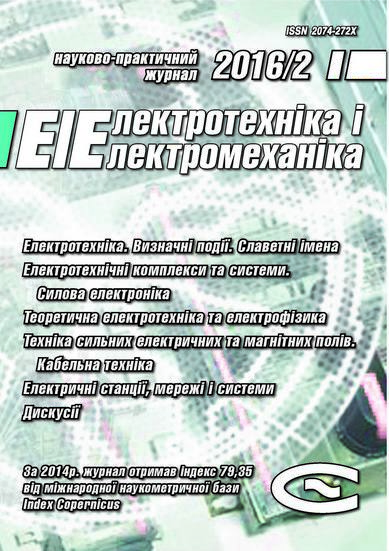ESTIMATING THE LIMIT POSSIBILITIES OF THE STEP CHARGING SYSTEM FOR CAPACITIVE ENERGY STORAGE
DOI:
https://doi.org/10.20998/2074-272X.2016.2.06Keywords:
capacitive energy storage, step-charged system, analytical analysis, electrical circuits, inductive energy storageAbstract
The aim of the article is to estimate the limit possibilities of step-by-step charging the capacitive energy storage which are caused by the achievement of a balance among the processes of the receiving and losing of electromagnetic energy. Originality. For the first time a step the charging system as a high power converter for pulsed load was considered, that allow to simplify similar charging systems and make its chipper while saving output characteristics and common quality. Methodology of the analysis applied is based on the classic electric circuits theory. All of the resulted carried out, were obtained as the differential equation solutions and its behavior was analyses analytically. Results. The basic diagram of the step-by-step charging system what is an alternative to the traditional variant with the step-up transformer was described. This system realizes the serial charge voltage increasing by the separate portions of energy, which has been, accumulated preliminary in the inductive energy storage. The formulas for estimating the limit possibilities of the step-by-step charging were got. These limits are caused by achieving a balance of the entering and losing electromagnetic energy. The applicability of the formulas was illustrated by numerical examples. Practical value. According to the results that were obtained, it is possible to note, that the step charging system is acceptable to be used as a high power converter for capacitive storage charging.
References
1. Batygin Yu.V., Lavinskiy V.I., Khimenko L.T. Impul'snyye magnitnyye polya dlya progressivnykh tekhnologiy. Tom 1. Izdaniye vtoroye, pererabotannoye i dopolnennoye. [Pulsed magnetic fields for advanced technologies. Vol.1. 2nd edition, revised and enlarged.] Kharkov, MOST-Tornado Publ., 2003.
p. (Rus).
2. Orlov B.D., Dmitriyev Yu.V., Chakalev A.A., Sidyakin V.A., Marchenko A.L. Tekhnologiya i oborudovaniye kontaktnoy svarki [Technology and equipment for the contact welding]. Moscow, Mechanical Engineering Publ., 1975. 536 p. (Rus).
3. John D. Lenk. Simplified Design of Switching Power Supplies. Elsevier Publishing House, 1996. 235 p. Electronic ISBN: 9780080517209.
4. Marasco K. How to Apply DC-to-DC Step-Up (Boost) Regulators. Analog Devices. AN-1132 Application Note: 2011. Available at: http://www.analog.com/media/ru/technical-documentation/application-notes/AN-1132.pdf (accessed 22 May 2012).
5. Atabekov G.I. Osnovy teorii tsepei [The base of the circuits theory]. Moscow. Energy Publ., 1969. 427 p. (Rus).
Downloads
Published
How to Cite
Issue
Section
License
Copyright (c) 2016 Yu. V. Batygin, E. A. Chaplygin, O. S. Sabokar

This work is licensed under a Creative Commons Attribution-NonCommercial 4.0 International License.
Authors who publish with this journal agree to the following terms:
1. Authors retain copyright and grant the journal right of first publication with the work simultaneously licensed under a Creative Commons Attribution License that allows others to share the work with an acknowledgement of the work's authorship and initial publication in this journal.
2. Authors are able to enter into separate, additional contractual arrangements for the non-exclusive distribution of the journal's published version of the work (e.g., post it to an institutional repository or publish it in a book), with an acknowledgement of its initial publication in this journal.
3. Authors are permitted and encouraged to post their work online (e.g., in institutional repositories or on their website) prior to and during the submission process, as it can lead to productive exchanges, as well as earlier and greater citation of published work.




